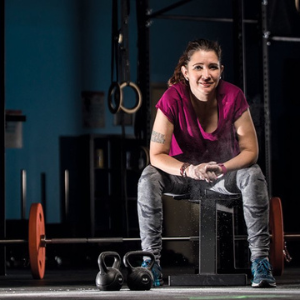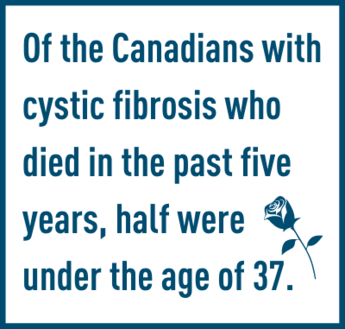During my second year of university, my health took a serious hit. I went from 95% FEV1 to 65% FEV1 and was no longer able to play sports. As an athlete, I was devastated. For several years I struggled to do treadmill work, spa lady circuit training and walking. I had to figure out how to get exercise back in my life. Exercise is like air to me. I need it to live. I knew that for me, exercise was extremely helpful for my airway clearance. I had my first CrossFit training session in 2013 and my life was changed forever.
CrossFit is functional fitness that combines respiratory and cardio endurance with flexibility, stamina, balance, agility and accuracy in all tasks performed. The strength and endurance I was building through CrossFit became a way to enhance my competency in performing typical daily physical tasks such as bringing in groceries, reaching for an item on the top shelf or simply going for a walk.
By maintaining my exercise regime for the last 15 years, I have maintained a 40% lung function. I did experience a drop down to the 30’s but have remained stable, which I attribute to my treatment compliance and exercise routine. Now, I believe that exercise with airway clearance, in particular the flutter, and Trikafta, is the perfect combination to keep my lungs clear as a bell.
“You don’t have to be an athlete to change the way you live; you just have to want to start. You are worth it!”
.png)
Staying motivated
Of course, there are days when it is hard to motivate myself. On the days where I feel like skipping the gym, or unmotivated because I am dealing with an exacerbation with a PICC line in my arm, I find there are three things I like to remind myself of to stay motivated.
- One workout is better than no workout: I remind myself to start, do my best and see where it goes. I always leave feeling accomplished with what I could do knowing that something is better than nothing.
- I am in control of my fate: I find it helpful to remind myself that I am lucky to be able to exercise to the complexity that I do and that it’s my job to take as best care of myself as possible.
- Turning motivation into discipline is my key to success: I do this by reminding myself of how far I have come, remembering the feeling after a great workout and knowing this this will all pay off.
“Exercise is like air to me. I need it to live.”
.png)
What works for me
While we all have an individual relationship with exercise, what worked for me was starting slow and increasing the frequency of my workouts over time. I suggest the same for my clients with cystic fibrosis, starting with two workouts a week and slowly increasing that amount depending on how they feel. Each workout can be anywhere from 5-45 minutes depending on your goals, time available and ability.
You can start small by incorporating more steps into your day by walking to nearby stores, doing five minutes of yoga or any other physical activity that is within your ability that you can use to measure success over time. When you’re ready, you can add in strength building to your routine.
Here is an example program that worked for me: The following workout is to be completed by doing as many repetitions (reps) as possible (AMRAP) in 10 minutes. 30 reps are considered one completed round.
- 10 sit ups
- 10 wall push ups
- 10 step ups (using a stool or a stair)
It’s important to consult your clinic team before starting a new exercise program.
Nicki Perkins is a 50-year-old CrossFit trainer living with cystic fibrosis and 28% lung function. In 2014, Nicki was named Calgary’s philanthropist of the year after donating more than $2 million through her organization, Summit Foundation for Cystic Fibrosis, for the University of Calgary. If you would like to know more about Nicki’s fitness journey, click here.





